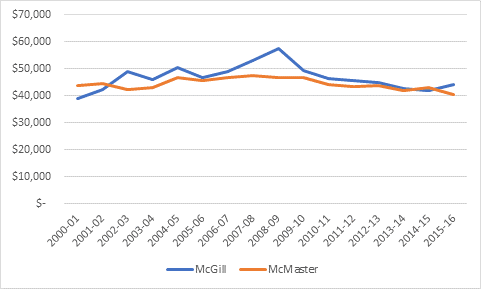The Shanghai Rankings (technically, the Academic Ranking of World Universities) came out a couple of weeks ago. This is the granddaddy of all international rankings; the one that started it all, and still perceived as the most stable and reliable measure of scientific hubs; essentially it measures large concentrations of scientific talent. And there were some very interesting results for Canada, the most intriguing of which is the fact that McGill has fallen out of Canada’s “top 3”, replaced by McMaster.
So, first of all the big picture: Toronto was up four places to 23rd in the world (and 10th among publics, if you consider Oxford, Cambridge and Cornell to be public), while UBC rose three places to 31st. McMaster and McGill rounded out Canadian institutions in the top 100 (more on them in a second). Below that, University of Alberta stayed steady in the 101-150 bracket, while Université de Montreal was joined by Calgary and Ottawa in the 151-200 bracket, bringing the national total in the top 200 to 8. Overall, the country stayed steady at 19 institutions in the top 500, though Université du Québec dropped out and was replaced by Concordia; that puts the country behind the US, the UK, China, Germany, Australia and France but ahead of everyone else (including, surprisingly, Japan, which has been doing terribly in various rankings of late).
But the big story – in Canada, anyway – is that McMaster rose 17 places to 66th overall while McGill dropped four places to 67th. This is the first time in any ranking (so far as I can recall) that McGill has not ben considered one of the country’s top three institutions, and so it raises some significant questions. Is it a matter of McGill’s reputation going down? An echo of l’Affaire Potter? A consequence of long-term funding decline? What, exactly?
The answer is it’s none of those things. Alone among the major rankings, Shanghai does not survey academics or anyone else about institutions, so it has nothing to do with image, reputation, prestige or anything else. Nor, by the way, is funding a credible suspect. Although we’re always hearing about how McGill is hard done by the Quebec government, the fact of the matter is that McGill has done as well or better than McMaster in terms of expenditures per student.
Figure 1-Total Expenditure per FTE Student, 2000-01 to 2015-16
Source: Statistics Canada’s Financial Information of Colleges and Universities & Post-Secondary Student Information System, various years
So what happened? It’s pretty simple, actually. 20% of the Shanghai rank is based on what is called the “HiCi list” – the list of Highly Cited researchers put out annually by Clarivate (formerly Thompson Reuters), which you can peruse here. But Clarivate has changed its HiCi methodology in the last couple of years, which has had a knock-on effect for the Shanghai rankings as well. Basically, the old method rewarded old researchers whose publications had gathered lots of citations over time; the methodology only counts citations in the past ten years and therefore privileges newer, “hotter” research papers and their authors (there’s a longer explanation here if you want all the gory details).
Anyway, the effect of this appears to be significant: McGill had five highly-cited researchers in both 2015 and 2016, while McMaster went from ten to fifteen – all in the Faculty of Health Sciences, if you can believe it – putting them top in Canada. Those extra five researchers were enough, in a ranking which is highly sensitive to the presence of really top scholars, to move McMaster above McGill.
So let’s not read anything more into this ranking: it’s not about funding, or reputation: it’s about a cluster of extraordinary research excellence which in this instance is giving a halo effect to an entire university. C’est tout.


 Tweet this post
Tweet this post

Good analysis.
Thank you!
Who considers Cornell to be a public university?
It is mostly private, but a) it;s a land-grant b) state of NY names three members to board, c) four of its colleges are state-supported.
Arguably, then, the same could be said of M.I.T. It was originally a land grant, and its heavy involvement in/reliance on defence research is perhaps more profoundly “public” than Cornell’s operation of a few (government) contract colleges (assuming that we can still characterize accurately the U.S.’s defense establishment as part of the public sector 😉 ).